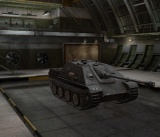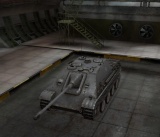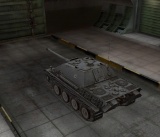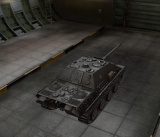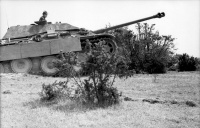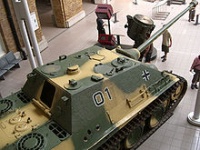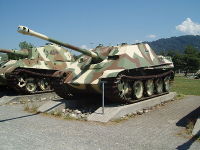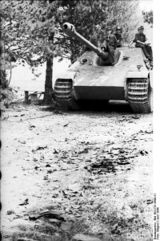Jagdpanther
The Jagdpanther is a German tier 7 tank destroyer. The Jagdpanther, along with most lower tier German tank destroyers, boasts an accurate gun, high mobility, and decent armor. It has similar speed and the same armor of the PzKpfw V Panther, and, with the hitting power of the 10.5cm K 18 L/52, is able to pose a threat to all tanks. The Jagdpanther has a low profile which makes it harder for enemy tanks to spot if you are in cover.
- Research leads to the Ferdinand.
JagdPanther/ModulesJagdPanther/EquipmentJagdPanther/Consumables
Historical Info
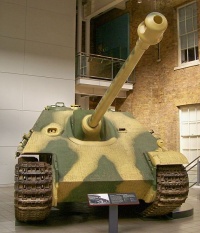
The Jagdpanther (German: "hunting panther") was a tank-destroyer built by Nazi Germany during World War II based on the chassis of the Panther tank. It entered service late in the war (1944) and saw service on the Eastern and Western fronts.
Many military historians consider the Jagdpanther to be one of the best tank-destroyers of the war due to the combination of the very-powerful 8.8 cm KwK 43 and the well-armored Panther chassis.
Development
A heavy tank-destroyer design based on the 8.8 cm Pak 43 gun and the Panther tank chassis was ordered in late 1942 as design SdKfz 173. Production started in January 1944. In February, Hitler specified the Jagdpanther name.
To accommodate the heavier-caliber gun, much as on previous Jagdpanzer-style unturreted tank-destroyers, the glacis plate and sides of the Jagdpanther were extended up into an integral, turretless fixed-casemate as part of the main hull itself to provide a roomy interior. The Jagdpanther had side armor of increased thickness to offset the slightly reduced angle of the side armor necessary to provide enough interior space. The new (April 1944) Panther Ausf. G had the same feature, to harmonize production and increase protection.
It was armed with an anti-tank version of the same long-barreled 8.8 cm gun as the Tiger II "King Tiger" and a single 7.92 mm MG-34 machine gun in the front glacis plate for local defence. The Jagdpanther had a good power-to-weight ratio and a powerful main gun, which enabled it to destroy any type of Allied tank. Based on the existing Panther chassis, the vehicle did not suffer too many mechanical problems: it had an upgraded transmission and final drive to counter the Panther's main weakness. It was manned by a crew of 5; a driver, radio-operator, commander, gunner, and loader.
Two main variants can be distinguished; the earlier (1944 model) G1 with a small internally-bolted main gun mantlet and a modified Panther A engine deck, and the later (1945 model) G2 with a larger, outside-bolted mantlet and a modified Panther G engine deck, though late G1s also had the larger mantlet. Early Jagdpanthers had two vision openings for the driver, whereas late versions had only one. The main gun originally had a monobloc gun barrel, but later versions were equipped with the Pak 43/4 gun with a 2-part barrel. Early G1s (to September 1944) were coated with the distinctive resin paste 'zimmerit' in a distinctive 'small-squared' pattern.
Production
A total of 415 Jagdpanthers were produced from January 1944 by three manufacturers. MIAG produced 270 from January 1944 until the end. Maschinenfabrik Niedersachsen-Hannover (MNH) produced 112 from November 1944. Maschinenbau und Bahnbedarf (MBA) produced 37 vehicles from December 1944. They equipped heavy anti-tank battalions and served mainly on the Eastern Front, although significant numbers were concentrated in the west for the Ardennes Offensive. They were first encountered in the west in very small numbers late in the Battle of Normandy, where the German 654 schwere Panzerjäger-Abteilung ("654th Heavy Antitank Battalion") deployed about 12 Jagdpanthers against British units.
